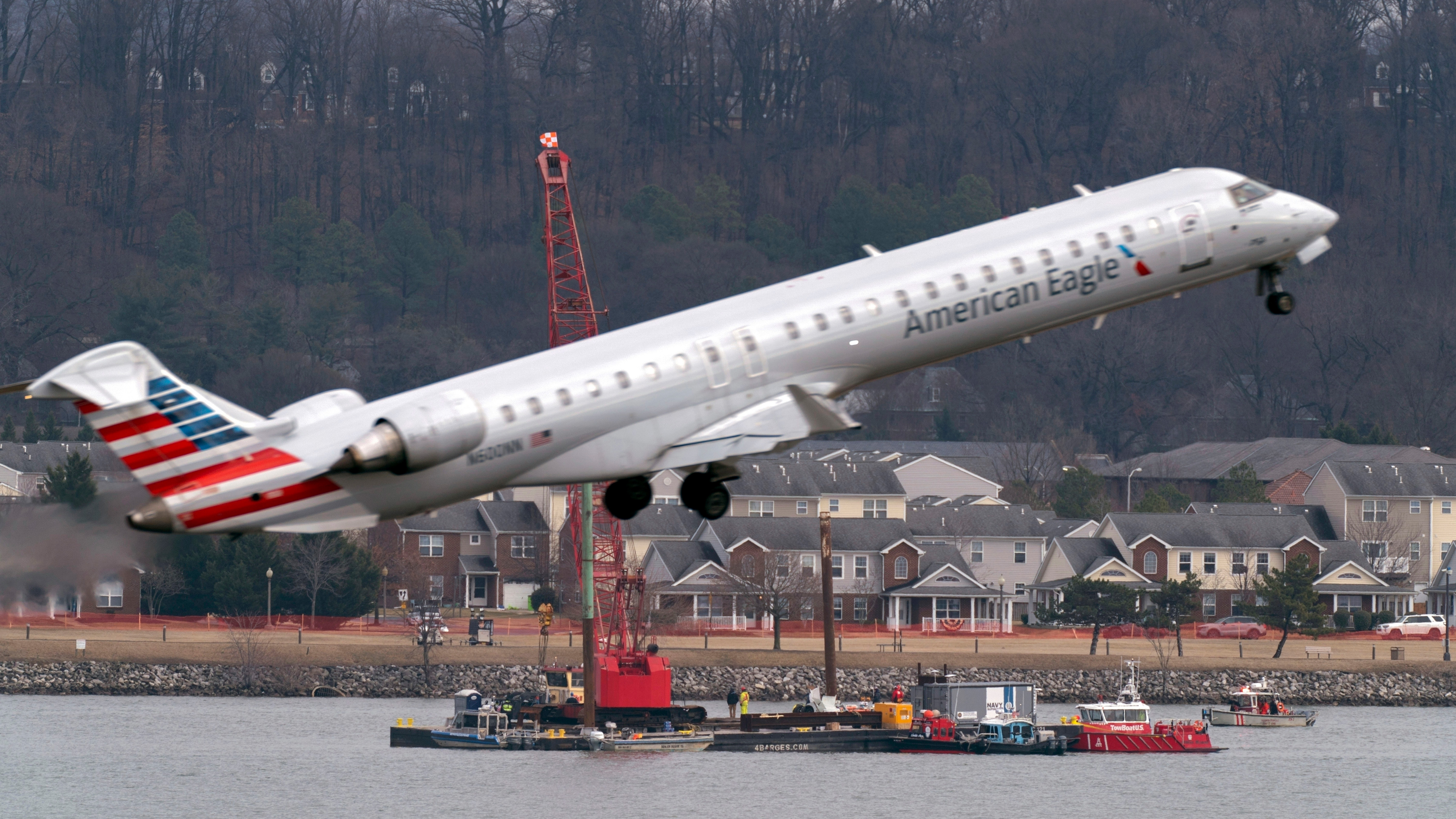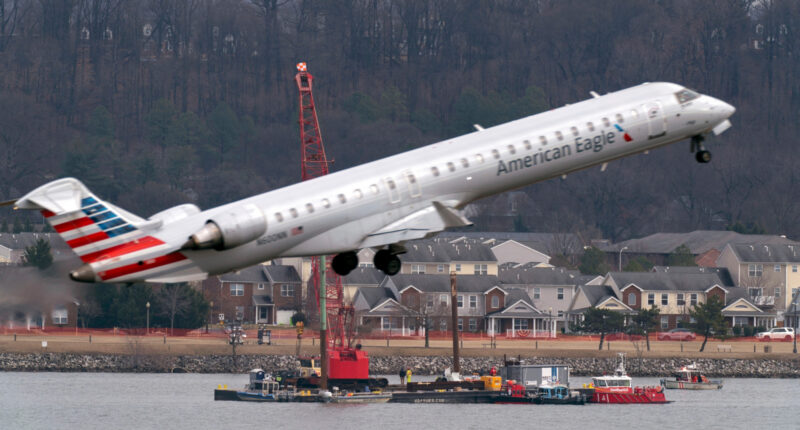Share this @internewscast.com
Investigators examining the January midair collision involving a passenger plane and an Army helicopter over Washington, resulting in 67 fatalities, discovered that the helicopter was flying higher than it should have been and the altitude readings it received were inaccurate.
The National Transportation Safety Board hearings in Washington uncovered these details on the first day, as investigators attempted to unearth the causes of the crash between the American Airlines aircraft from Wichita, Kansas, and the Black Hawk helicopter above Ronald Reagan National Airport.
The board commenced the three-day hearings with an animation, alongside audio and video from the night of the collision. They also questioned witnesses and investigators regarding the potential contributions of the Federal Aviation Administration and the Army to the nation’s deadliest plane crash since November 2001.
The American Airlines plane collided with a Black Hawk helicopter at Ronald Reagan National Airport.
It’s likely too early for the board to identify what caused the crash.
This incident in January marked the first in a series of crashes and near misses this year that have raised concerns among officials and the traveling public, although data still indicates that flying remains the safest mode of transportation.
Animation, altimeter discrepancy
The hearing began on Wednesday with a video animation depicting the trajectories of the helicopter and airliner leading up to the collision. The animation illustrated how the helicopter exceeded the 200-foot (61-meter) altitude restriction on the designated helicopter path along the Potomac River before it collided with the plane.
On Wednesday, investigators noted that the helicopter’s flight data recorder indicated an altitude 80 feet to 100 feet (24 to 30 meters) higher than the barometric altimeter readings the pilots were using. Consequently, the NTSB conducted tests on three other helicopters from the same unit, flying over the same area, and found similar altimeter discrepancies.
Dan Cooper with Sikorsky helicopters said that when the Black Hawk helicopter involved in the crash was designed in the 1970s, it used a style of altimeter that was common at the time. Newer helicopters have air data computers that didn’t exist back then that help provide more accurate altitude readings.

Salvage crews work on recovering wreckage near the site in the Potomac River of a mid-air collision between an American Airlines jet and a Black Hawk helicopter.
AP Photo/Jose Luis Magana, File
Chief Warrant Officer Kylene Lewis told the board that she wouldn’t find an 80 to 100 foot discrepancy between the different altimeters on a helicopter alarming because at lower altitudes she would be relying more on the radar altimeter than the barometric altimeter. Below 500 feet (152 meters) , Lewis said she would be checking both instruments and cross referencing them.
She said as long as an altimeter registers an altitude within 70 feet of the published altitude before takeoff the altimeter is considered accurate under the checklists.
But previously, NTSB Chairwoman Jennifer Homendy highlighted that the published helicopter routes around Washington D.C. would allow planes and helicopters to routinely come within 75 feet of each other during landing.
Army officials said Wednesday that the flight manual for these older Black Hawks doesn’t highlight the discrepancies in altimeters that has been documented previously, but typical flight separations are at least 500 feet around airports.
Previously disclosed air traffic control audio had the helicopter pilot telling the controller twice that they saw the airplane and would avoid it. The animation ended with surveillance video showing the helicopter colliding with the plane in a fiery crash.
Investigations have already shown the FAA failed to recognize a troubling history of 85 near misses around Reagan airport in the years before the collision, and that the Army’s helicopters routinely flew around the nation’s capitol with a key piece of locating equipment, known as ADS-B Out, turned off.
Aviation attorney Bob Clifford, who is working to file one of the first lawsuits against the government next month, said he hopes NTSB will look beyond the immediate factors that caused this crash to highlight the bigger ongoing concerns in the crowded Washington airspace.
Proposed changes
Even though the final NTSB report won’t be released until sometime next year, U.S. Sen. Ted Cruz isn’t waiting to propose changes. He introduced legislation Tuesday that would require all aircraft operators to use both forms of ADS-B, or Automatic Dependent Surveillance Broadcast, the technology to broadcast aircraft location data to other planes and air traffic controllers. Most aircraft today are equipped with ADS-B Out equipment but the airlines would have to add the more comprehensive ADS-B In technology to their planes.
“There cannot be a double standard in aviation safety,” Cruz said. “We should not tolerate special exceptions for military training flights, operating in congested air space.”
The legislation would revoke an exemption on ADS-B transmission requests for Department of Defense aircrafts. It also would require the FAA to evaluate helicopter routes near airports and require the Army Inspector General to review the Army’s aviation safety practices.
Homendy said her agency has been recommending that move for decades after several other crashes.
Transportation Secretary Sean Duffy said that while he’d like to discuss “a few tweaks,” the legislation is “the right approach.” He also suggested that the previous administration “was asleep at the wheel” amid dozens of near-misses in the airspace around Washington’s airspace.
‘Fact-finding proceeding’
Homendy said the hearings over the next few days will be a “fact-finding proceeding.” The NTSB will also post thousands of pages of evidence from the crash investigation online.
FAA Administrator Bryan Bedford said that he expects “we’re going to have some very uncomfortable conversations over the next two and a half days” but that “they need to be had in the clear light of day – and simply put the best interest of the traveling public ahead of any of our personal interests, perhaps.”
The hearings in Washington involve NTSB board members, investigators and witnesses for organizations involved in the crash. Panels will focus on military helicopter routes in the Washington area, collision avoidance technology and training for air traffic controllers at Ronald Reagan National Airport, among other subjects.
Federal officials have also raised concerns over the nation’s outdated and understaffed air traffic control system. During January’s mid-air crash above Washington, one controller was handing both commercial airline and helicopter traffic at the busy airport.
Duffy has announced a multi-billion-dollar plan to overhaul the system controllers use that relies on old technology like floppy disks.
Copyright © 2025 by The Associated Press. All Rights Reserved.
















